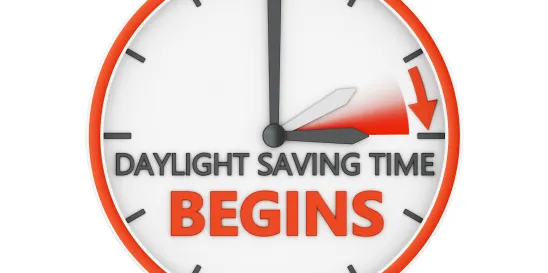On Sunday, March 10, 2024, people in most states will turn back their clocks one hour at 2:00 a.m., marking the start of daylight saving time, which is meant to allow people to take advantage of more daylight. However, the seasonal changing of the clocks for daylight saving time can disrupt individuals’ sleep patterns and have unintended consequences for workplace safety, and studies have revealed a correlation between the transition to daylight saving time and an increase in workplace injuries.
Quick Hits
- People in most states will turn their clocks forward one hour at 2:00 a.m. on Sunday, March 10, 2024, for the start of daylight saving time.
- Some studies suggest the transition to daylight saving time leads to a spike in workplace accidents due to disruptions to workers’ sleep schedules.
- Employers may want to take note of the potential increased risks to workplace safety potentially caused by daylight saving time.
While most states follow daylight saving time—Arizona and Hawaii are the only exceptions—the process of changing clocks twice a year is not preferred by everyone, particularly in the spring when the clocks are moved forward and an hour is lost. Employers may want to take note that the shift can cause people to lose sleep and there is some evidence that this leads to a spike in workplace injuries in the days following the shift.
Daylight Saving Time
Daylight saving time requires clocks to be turned forward one hour in the spring at 2:00 a.m. on the second Sunday of March, and then turned back one hour in the fall at 2:00 a.m. on the first Sunday of November, hence the mnemonic phrase “spring forward, fall back.” The rationale for daylight saving time—which was historically popularized by a satirical essay written by Benjamin Franklin—is to align the typical waking hours for individuals and their workdays within the hours between sunrise and sunset, which shift between winter and summer.
The U.S. Congress adopted daylight saving time across the country with the Uniform Time Act of 1966, which as originally written called for the start of daylight saving time to begin on the last Sunday in April and end on the last Sunday in October. Daylight saving time was later extended by an amendment to the Energy Policy Act of 2005, which moved the spring and fall start and end dates to the current setup.
However, there has been debate in recent years over the necessity of switching back and forth from daylight saving time each year given the modern-day workplace and the disruption it causes. In 2022, the U.S. Senate even passed a bill, called the Sunshine Protection Act, that would have made daylight saving time permanent (and would have stopped the changing of clocks moving forward), but it did not progress further.
Potential Negative Impacts
The changing of the clocks, particularly in the spring when the clocks are turned forward an hour (meaning an hour is lost), can disrupt individuals’ circadian rhythms and impact their sleep. Studies have shown the disruption may have unintended potential negative impacts on human health and some studies have shown it may specifically lead to an increase in workplace accidents immediately following the change.
One such study reviewed data from the National Institute for Occupational Safety and Health database of mining injuries from 1983 through 2006, and found that the Mondays after the change to daylight saving time had more workplace injuries and more severe injuries than any other days. Another study by the same group looking at data gathered by the U.S. Department of Labor’s (DOL) Bureau of Labor Statistics from 2003 to 2006, found indirect evidence that individuals’ lack of sleep caused by the transition may affect the rate of injuries, finding that workers get an average of forty minutes less sleep on the Monday following the start of daylight saving time than on other days.
Next Steps
Before the digital age, many employers would constantly remind employees to turn their manual clocks back. With that burden gone, employers may want to dig deeper and consider the workplace safety risks associated with daylight saving time and the seasonal changing of the clocks and consider hazard mitigation strategies. For example, employers may want to consider adjusting work schedules and/or encouraging fatigued employees to take breaks while they adjust to the time change. Employers may further want to provide information and resources to employees on sleep management and to encourage healthy sleep patterns around seasonal clock changes.





 />i
/>i

